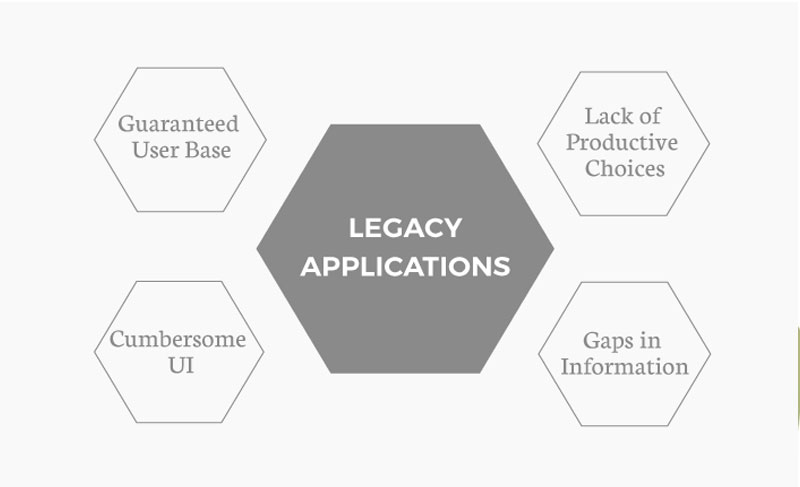
Legacy applications are a common challenge for organizations that rely on outdated software. While these applications may still be functional, they can pose significant risks to the security and stability of an organization’s IT infrastructure. One solution is to migrate these legacy applications to newer platforms or systems that are better equipped to handle their needs. This can involve a significant investment of time and resources, but it can also provide long-term benefits in terms of improved performance, scalability, and security.
Challenges with legacy application
Legacy applications, while still useful, can pose several challenges that need to be addressed. Outdated software and hardware can create security risks that must be mitigated through regular updates and patches. Integration with newer systems and technologies can also be a challenge, but it is essential to ensure that legacy applications continue to function effectively. The increased costs associated with maintenance and support of legacy applications can also be a concern, but investing in modernization efforts can help alleviate these issues over time.
Ultimately, striking a balance between functionality, security, and compatibility requires careful planning and ongoing attention to the evolving technology landscape. By prioritizing these considerations, organizations can ensure that their legacy applications continue to serve their needs while remaining secure and compatible with new technologies.
Replacing legacy applications can be a complex and costly process
Organizations must carefully weigh the benefits and risks before making a decision. They need to consider factors such as the cost of development, the impact on existing workflows, and the potential for data loss or security breaches during migration. In some cases, it may be more practical to continue using legacy applications while implementing security measures to protect against cyber threats.
Apply Design thinking while converting any legacy application to modern
As part of the UX research process when transforming a legacy application to a modern one, it is recommended to ask the following questions to users. This aligns with design thinking principles, which encourage designers to consider user needs before beginning the design process. Gathering user feedback through this survey can provide valuable insights that can be used to improve the modern application in line with user input.
Here are some UX questions that you can ask your clients who are using your legacy application:
Question 1: Which of the following issues do you face while using our <application name>?
A. Slow page loading times
B. Difficult to navigate and find what you need
C. Limited search functionality
D. Inconsistent user interface E. Other (please specify)
Question 2: What are the top features you use in our <application name>?
A. <mention feature here>
B. <mention feature here>
C. <mention feature here>
D. <mention feature here>
E. Other (please specify) <use text area here >
Question 3: Which of the following features do you wish our <application name> had?
A. <mention feature here>
B. <mention feature here>
C. <mention feature here>
D. <mention feature here>
E. Other (please specify) <use text area here >
Question 4: Which of the following devices do you use to access our<application name>?
A. Desktop computer
B. Laptop computer
C. Tablet
D. Smartphone
E. Other (please specify)
Question 5: How frequently do you use our application?
A. Daily
B. Weekly
C. Monthly
D. Rarely
E. Other (please specify)
Question 6: How easy is it to learn and use our application?
A. Very easy
B. Somewhat easy
C. Neutral
D. Somewhat difficult
E. Very difficult
Question 7: How satisfied are you with our application overall?
A. Very satisfied
B. Somewhat satisfied
C. Neutral
D. Somewhat dissatisfied
E. Very dissatisfied
Question 8: Which of the following improvements would you like to see in our new application?
A. Faster page loading times
B. Improved navigation and search functionality
C. Consistent user interface
D. More features E. Other (please specify)
Question 9: How important is it for our new application to be mobile-friendly?
A. Very important
B. Somewhat important
C. Neutral
D. Not very important
E. Not at all important
Question 10: How important is it for our new application to integrate with other systems and tools?
A. Very important
B. Somewhat important
C. Neutral
D. Not very important
E. Not at all important
Question 11: Which of the following tasks do you primarily use our <application name> for?
A. <enter task name here>
B. <enter task name here>
C. <enter task name here>
D. <enter task name here>
E. Other (please specify)
Question 12: Which of the following factors are important to you when using our<application name>?
A. Security and privacy
B. Ease of use
C. Customizability
D. Flexibility E. Other (please specify)
Question 13: How well does our application meet your needs compared to other similar applications in the market?
A. Much better
B. Somewhat better
C. About the same
D. Somewhat worse
E. Much worse
Question 14: How do you usually get help when you encounter issues while using our application?
A. Online help documentation
B. Contacting customer support
C. Asking a colleague
D. Trial and error
E. Other (please specify)
Question 15: How likely are you to recommend our application to a colleague or friend?
A. Very likely
B. Somewhat likely
C. Neutral
D. Somewhat unlikely
E. Very unlikely
Question 16: How important is it for our new application to have a modern and visually appealing design?
A. Very important
B. Somewhat important
C. Neutral
D. Not very important
E. Not at all important
Question 17: How often do you encounter errors or bugs while using our application?
A. Frequently
B. Occasionally
C. Rarely
D. Never
E. Other (please specify)
Question 18: Which of the following methods do you prefer for receiving updates and notifications about our new application?
A. Email notifications
B. In-app notifications
C. Push notifications on mobile devices
D. Social media updates
E. Other (please specify)
Question 19: If you are open to 1:1 User interview for 20 minutes, drop in your email id/mobile number
<display text area>
The questions outlined in the UX survey can help you gather insights into user pain points, needs, and preferences. By considering this feedback, you can design a modern application that addresses user needs and offers an improved user experience. Ultimately, this can lead to increased user satisfaction, better adoption rates, and a more successful transformation of your legacy application.


